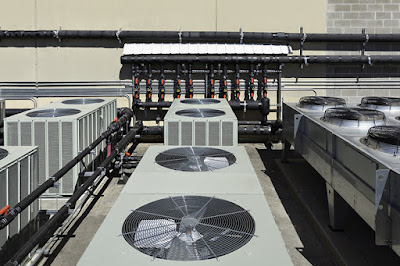HVAC chiller is a key component of many commercial and industrial cooling and refrigeration systems. A chiller is a machine that removes heat from a liquid via a vapor-compression . Industrial chillers are generally installed in a mechanical equipment room, beside an industrial process, or outside the building. Residential HVAC chillers can be installed in a storage tank next to the home. Chiller system changes the physical state of refrigerant to transfer heat from one area to another. The laws of pressure-temperature relationship state that increased pressure on a refrigerant increases its temperature while decreased pressure lowers its temperature. As the refrigerant circulates through the HVAC chiller, various components change its pressure and temperature, causing it to boil into a gas and condense into a liquid. During the change of state from liquid to gas, the refrigerant absorbs heat, and the refrigerant releases heat when it returns to its liquid state.
Types of Chillers-
Chiller Types have been designed to cater to the diversified requirement of industrial chillers Water chillers have evolved due to the variety in availability of type of energy at industry or small level.Types of chillers have made the use of the chillers flexible in terms of energy input.
The Cooling Cycle of an HVAC Chiller-
- Compressor to Condenser: The compressor sends hot refrigerant gas to the condenser, where the refrigerant’s heat is transferred to the cold water outside the component. As it cools, the refrigerant turns into a liquid.
- Condenser to Metering Device: The metering device limits the flow of the liquid refrigerant causing it to drop in pressure which reduces its boiling point. The refrigerant quickly boils into a gas in a process known as adiabatic flash evaporation or auto-refrigeration.
- Metering Device to Evaporator: As the refrigerant changes state into a gas, the metering device sends it to the evaporator. While vaporizing, the refrigerant absorbs heat from the warm water outside the chiller and cools the surrounding area.
- Evaporator to Compressor: The warm refrigerant gas is sent from the evaporator to the compressor, where its pressure and temperature are elevated. A hot gas again, the refrigerant travels to the condenser, releasing its heat and beginning the cycle again.
We Offer Design, Installation, Operation and Maintenance Services...


Very well explained thanks for sharing such an useful information. Gas refrigerator
ReplyDelete